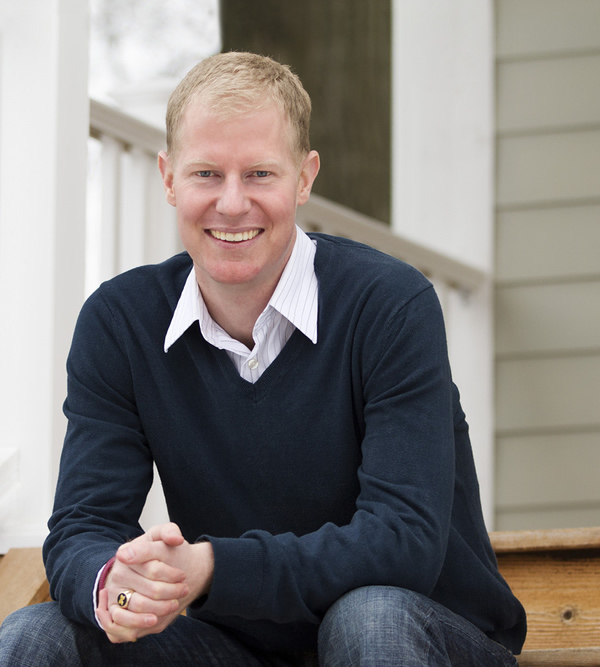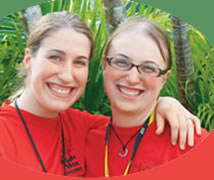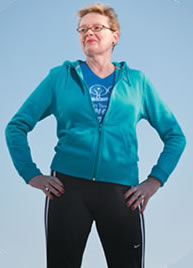Steps of Hope

Cancer awareness walks raise more than money
Phil Brabbs is aiming for domination -- which makes sense if you know him as a former University of Michigan football player. But if you meet Brabbs these days, you wouldn't necessarily think of "domination" as you chat with this exceedingly polite, laid-back family man. That is, until he tells you about multiple myeloma.
A day after his 28th birthday, Brabbs was diagnosed with multiple myeloma -- an illness whose median age at diagnosis is 68. Now 30 and married with three young children, Brabbs is determined to find a cure for his disease. While still undergoing aggressive treatment, he started the Cancer Kicker Foundation to support multiple myeloma research at the University of Michigan Rogel Cancer Center.
The organization taps into volunteers' creativity, providing fund-raising tools for volunteers who would like to raise awareness as well as dollars. One of the many events Cancer Kicker volunteers are participating in this year is the Dexter-Ann Arbor Run.
"The ultimate mission of the organization is to encourage people to dominate life," Brabbs says. "To live with passion and energy, and especially for those diagnosed with cancer, to look beyond it and live passionately. I'm living that out, and I'm encouraging everyone to do that as well."
With that in mind, we've put together the top three reasons our patients have chosen to direct their passion toward participating in cancer awareness walks. No matter which charity you choose to support, you're likely to gain.
STEP 1: Walk Because Your Cause Is Important

Don't be shy about asking for donations. Asking for money may seem daunting, but people like to give to good causes -- especially if you can convey how important that cause is to you.
When it became clear in 1998 that Emily Avers would need a blood stem-cell transplant to treat her non-Hodgkin's lymphoma, she turned to her only sibling, Laura Duda. Doctors told her that siblings only have a one in four chance of matching. Laura did. Ten years later, the sisters decided it was time to commemorate the procedure, which eradicated the cancer. Avers and Duda flew to Jamaica to walk a half-marathon for the Cancer Support Community (which at that time was known as The Wellness Community of Southeast Michigan).
"The walk was a celebration of getting to that point," Avers says. We couldn't believe I was all of a sudden cured because no one wanted to say that word for a long time. But now that I had been cancer-free for so many years, I wanted to involve people in a cause that we both cared about. We wanted to support not only patients, but the kids and families of cancer survivors. It was easy to gather support for that."
STEP 2: Walk To Remember; Walk For Community
Walks, runs and other fundraising events happen year-round. Here are some recommendations:
- Ann Arbor's Cancer Support Community's Fundraising page contains information about the Amazing Race (a scavenger hunt) and the Strides for Hope walk.
- The American Cancer Society's Relay for Life.
- The American Cancer Society's Making Strides Against Breast Cancer.
Brian Darwin was an active guy: His work required physical labor. He raised four young athletes. He knew his body so well that he told his wife, Brenda, that he felt like a softball was growing inside of him even before doctors diagnosed him with pancreatic cancer.
"I think the hardest thing on him during the whole experience was his body failing him," Brenda Darwin said. "He was used to being so active and doing so much. Now he was limited."
So when one of Brenda's daughters found out about the Pancreatic Cancer Action Network's annual PurpleStride walk at the Detroit Zoo, the Darwin family decided it would be the perfect way to honor Brian, who by then was receiving hospice care. The family gathered again last fall and plan to make it an annual event.
For Brenda, the sense of community she felt during the walk was overwhelming.
"I think it's important to get involved, even though you might be apprehensive at first," Brenda said. "There's a feeling of comfort that comes over you just by being around other people who know what it's like. You feel like you know these people, even if you don't. You're all going through the same thing."
STEP 3: Walk To Show Cancer Who's Boss

Rachel McCormack can't help but notice the way her brain tumor has affected her body. Since undergoing surgery that removed 90% of the tumor, she hasn't been quite as steady as she used to be. Her eyesight suffers. But her legs are good, so she has set a lofty goal: to run the Chicago Marathon in October.
McCormack is a life-long runner, and this isn't the first time she's set her sights on a marathon. This time, though, it will be a little different. She will have her husband, Michael, right by her side to help guide her through the race as she runs to support the American Brain Tumor Association. Although McCormack is still receiving chemotherapy, she has begun training after consulting first with her neurooncologist, Larry Junck, M.D.
Junck encourages patients who can physically tolerate exercise to pursue it. Even light activity, such as walking around the house a couple times a day, helps maintain general health as well as bone and muscle strength while keeping up morale. In any case, the key is to gradually increase endurance.
As of February, McCormack was up to running about three miles. "You can let cancer make your life come to a halt -- and it is tough. But I think this is something I can do," McCormack says. "The tumor is still going to be there, but I'm going to feel like I've beaten it. I'm going to show it who's boss."
WALK SMART
G. Lita Smith, an acute care nurse practitioner in the University of Michigan multidisciplinary Breast Care Center, knows from experience what it takes to participate in a cancer awareness walk. To honor her patients and her mother -- who died 20 years ago of breast cancer -- she has walked many times in the Susan G. Komen Race for the Cure. Smith has even completed the 60-mile Komen 3-Day for the Cure twice, both times accompanied by her mother-in-law.
We asked Smith for her tips on training for cancer awareness walks. Here's what she had to say:
1. Talk to your doctor first. Exercise is good for you, but any time you begin a new fitness regimen -- whether it's to train for a cancer awareness walk or to improve your health -- you should talk to your health care team first.
2. If you're still on treatment or have recently completed treatment, manage your expectations. Even if you were very physically fit before treatment, you may find that you become more easily tired. Listen to your body. If you're feeling low on energy, consider exercising for shorter periods of time or every other day, rather than daily. However, don't assume exercise will make you more tired. Some studies have shown that exercise-particularly when done outdoors -- may actually fight attentional and physical fatigue.
3. For first-time walkers, consider Relay for Life. The American Cancer Society's annual Relay for Life starts each event with a lap for survivors. This is a relatively short walk that doesn't require serious training. You can also join a relay team, allowing you to manage how much you would like to walk throughout the event.
4. If you are in treatment or aren't up to walking, let your family and friends do it for you. Cancer awareness walks can be a powerful way for family and friends to show their support for you. Consider cheering them on from the sidelines or helping them with the online fund-raising aspects of the event.
Read the Spring, 2011 issue of Thrive.
